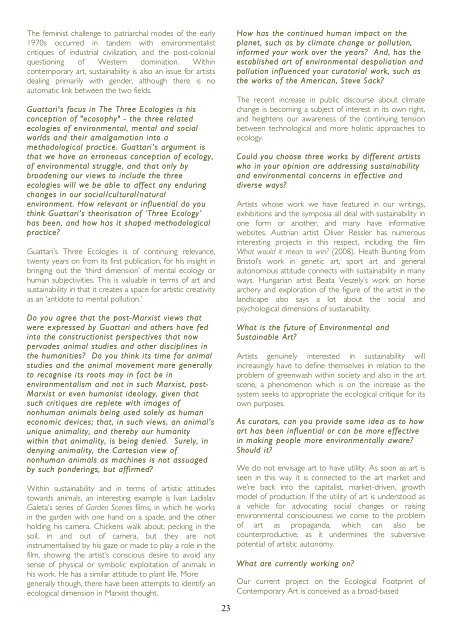M - Antennae The Journal of Nature in Visual Culture
M - Antennae The Journal of Nature in Visual Culture
M - Antennae The Journal of Nature in Visual Culture
You also want an ePaper? Increase the reach of your titles
YUMPU automatically turns print PDFs into web optimized ePapers that Google loves.
<strong>The</strong> fem<strong>in</strong>ist challenge to patriarchal modes <strong>of</strong> the early<br />
1970s occurred <strong>in</strong> tandem with environmentalist<br />
critiques <strong>of</strong> <strong>in</strong>dustrial civilization, and the post-colonial<br />
question<strong>in</strong>g <strong>of</strong> Western dom<strong>in</strong>ation. With<strong>in</strong><br />
contemporary art, susta<strong>in</strong>ability is also an issue for artists<br />
deal<strong>in</strong>g primarily with gender, although there is no<br />
automatic l<strong>in</strong>k between the two fields.<br />
Guattari's focus <strong>in</strong> <strong>The</strong> Three Ecologies is his<br />
conception <strong>of</strong> "ecosophy" - the three related<br />
ecologies <strong>of</strong> environmental, mental and social<br />
worlds and their amalgamation <strong>in</strong>to a<br />
methodological practice. Guattari's argument is<br />
that we have an erroneous conception <strong>of</strong> ecology,<br />
<strong>of</strong> environmental struggle, and that only by<br />
broaden<strong>in</strong>g our views to <strong>in</strong>clude the three<br />
ecologies will we be able to affect any endur<strong>in</strong>g<br />
changes <strong>in</strong> our social/cultural/natural<br />
environment. How relevant or <strong>in</strong>fluential do you<br />
th<strong>in</strong>k Guattari’s theorisation <strong>of</strong> ‘Three Ecology’<br />
has been, and how has it shaped methodological<br />
practice?<br />
Guattari’s Three Ecologies is <strong>of</strong> cont<strong>in</strong>u<strong>in</strong>g relevance,<br />
twenty years on from its first publication, for his <strong>in</strong>sight <strong>in</strong><br />
br<strong>in</strong>g<strong>in</strong>g out the ‘third dimension’ <strong>of</strong> mental ecology or<br />
human subjectivities. This is valuable <strong>in</strong> terms <strong>of</strong> art and<br />
susta<strong>in</strong>ability <strong>in</strong> that it creates a space for artistic creativity<br />
as an ‘antidote to mental pollution.’<br />
Do you agree that the post-Marxist views that<br />
were expressed by Guattari and others have fed<br />
<strong>in</strong>to the constructionist perspectives that now<br />
pervades animal studies and other discipl<strong>in</strong>es <strong>in</strong><br />
the humanities? Do you th<strong>in</strong>k its time for animal<br />
studies and the animal movement more generally<br />
to recognise its roots may <strong>in</strong> fact be <strong>in</strong><br />
environmentalism and not <strong>in</strong> such Marxist, post-<br />
Marxist or even humanist ideology, given that<br />
such critiques are replete with images <strong>of</strong><br />
nonhuman animals be<strong>in</strong>g used solely as human<br />
economic devices; that, <strong>in</strong> such views, an animal’s<br />
unique animality, and thereby our humanity<br />
with<strong>in</strong> that animality, is be<strong>in</strong>g denied. Surely, <strong>in</strong><br />
deny<strong>in</strong>g animality, the Cartesian view <strong>of</strong><br />
nonhuman animals as mach<strong>in</strong>es is not assuaged<br />
by such ponder<strong>in</strong>gs, but affirmed?<br />
With<strong>in</strong> susta<strong>in</strong>ability and <strong>in</strong> terms <strong>of</strong> artistic attitudes<br />
towards animals, an <strong>in</strong>terest<strong>in</strong>g example is Ivan Ladislav<br />
Galeta’s series <strong>of</strong> Garden Scenes films, <strong>in</strong> which he works<br />
<strong>in</strong> the garden with one hand on a spade, and the other<br />
hold<strong>in</strong>g his camera. Chickens walk about, peck<strong>in</strong>g <strong>in</strong> the<br />
soil, <strong>in</strong> and out <strong>of</strong> camera, but they are not<br />
<strong>in</strong>strumentalised by his gaze or made to play a role <strong>in</strong> the<br />
film, show<strong>in</strong>g the artist’s conscious desire to avoid any<br />
sense <strong>of</strong> physical or symbolic exploitation <strong>of</strong> animals <strong>in</strong><br />
his work. He has a similar attitude to plant life. More<br />
generally though, there have been attempts to identify an<br />
ecological dimension <strong>in</strong> Marxist thought.<br />
23<br />
How has the cont<strong>in</strong>ued human impact on the<br />
planet, such as by climate change or pollution,<br />
<strong>in</strong>formed your work over the years? And, has the<br />
established art <strong>of</strong> environmental despoliation and<br />
pollution <strong>in</strong>fluenced your curatorial work, such as<br />
the works <strong>of</strong> the American, Steve Sack?<br />
<strong>The</strong> recent <strong>in</strong>crease <strong>in</strong> public discourse about climate<br />
change is becom<strong>in</strong>g a subject <strong>of</strong> <strong>in</strong>terest <strong>in</strong> its own right,<br />
and heightens our awareness <strong>of</strong> the cont<strong>in</strong>u<strong>in</strong>g tension<br />
between technological and more holistic approaches to<br />
ecology.<br />
Could you choose three works by different artists<br />
who <strong>in</strong> your op<strong>in</strong>ion are address<strong>in</strong>g susta<strong>in</strong>ability<br />
and environmental concerns <strong>in</strong> effective and<br />
diverse ways?<br />
Artists whose work we have featured <strong>in</strong> our writ<strong>in</strong>gs,<br />
exhibitions and the symposia all deal with susta<strong>in</strong>ability <strong>in</strong><br />
one form or another, and many have <strong>in</strong>formative<br />
websites. Austrian artist Oliver Ressler has numerous<br />
<strong>in</strong>terest<strong>in</strong>g projects <strong>in</strong> this respect, <strong>in</strong>clud<strong>in</strong>g the film<br />
What would it mean to w<strong>in</strong>? (2008). Heath Bunt<strong>in</strong>g from<br />
Bristol’s work <strong>in</strong> genetic art, sport art and general<br />
autonomous attitude connects with susta<strong>in</strong>ability <strong>in</strong> many<br />
ways. Hungarian artist Beata Veszely’s work on horse<br />
archery and exploration <strong>of</strong> the figure <strong>of</strong> the artist <strong>in</strong> the<br />
landscape also says a lot about the social and<br />
psychological dimensions <strong>of</strong> susta<strong>in</strong>ability.<br />
What is the future <strong>of</strong> Environmental and<br />
Susta<strong>in</strong>able Art?<br />
Artists genu<strong>in</strong>ely <strong>in</strong>terested <strong>in</strong> susta<strong>in</strong>ability will<br />
<strong>in</strong>creas<strong>in</strong>gly have to def<strong>in</strong>e themselves <strong>in</strong> relation to the<br />
problem <strong>of</strong> greenwash with<strong>in</strong> society and also <strong>in</strong> the art<br />
scene, a phenomenon which is on the <strong>in</strong>crease as the<br />
system seeks to appropriate the ecological critique for its<br />
own purposes.<br />
As curators, can you provide some idea as to how<br />
art has been <strong>in</strong>fluential or can be more effective<br />
<strong>in</strong> mak<strong>in</strong>g people more environmentally aware?<br />
Should it?<br />
We do not envisage art to have utility. As soon as art is<br />
seen <strong>in</strong> this way it is connected to the art market and<br />
we’re back <strong>in</strong>to the capitalist, market-driven, growth<br />
model <strong>of</strong> production. If the utility <strong>of</strong> art is understood as<br />
a vehicle for advocat<strong>in</strong>g social changes or rais<strong>in</strong>g<br />
environmental consciousness we come to the problem<br />
<strong>of</strong> art as propaganda, which can also be<br />
counterproductive, as it underm<strong>in</strong>es the subversive<br />
potential <strong>of</strong> artistic autonomy.<br />
What are currently work<strong>in</strong>g on?<br />
Our current project on the Ecological Footpr<strong>in</strong>t <strong>of</strong><br />
Contemporary Art is conceived as a broad-based












